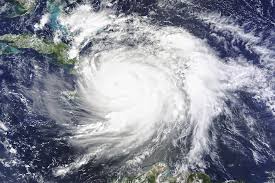We need to pay closer attention to storm devastation and climate change

As I scroll through the never-ending pages of my social media I can’t help but notice the extreme changes in emotion in each video I scroll to. Flipping from funny, to fear-inducing to heartbreaking and angering, right back to funny again all within a minute of scrolling through social media. The videos, pictures, and infographics I consume float can sometimes create a fog of anxiety that clouds my head throughout the school day.
Recently, on social media, the most clicks were going to Hurricane Milton. Warnings of 10-foot high storm surges and 160-mile-an-hour winds are predicted to hit Florida and what many thought was going to be a public outcry on national news turned into a whisper as major news stations around the country turned to cover the more imminent presidential election news. The emotional and financial hardships that arise from such a powerful hurricane, which will be far from the last of its size, don’t merit extensive long-term coverage by news stations.
In a case like Hurricane Milton, where so many evacuated and there were fewer deaths than expected, the aftermath of the hurricane was somewhat overlooked. As the back-to-back hurricanes in Florida end, so does the national coverage and public opinion.
The wind and rain move along, and so do national networks even though the most damaging parts of hurricanes occur for days, weeks, and months after. For example, sizable portions of Tampa Bay were left without power and many residents have been displaced. For many, the displacement is temporary; for others, it’s permanent. I believe journalism needs to highlight the stories that include the aftermath of hurricanes not just the deaths and the timely news that sells. Because not showing the aftermath of a hurricane dulls the fear and anxiety that we might feel next year.
In Asheville, North Carolina 100,000 people did not have water for two weeks due to Hurricane Helene, as the North Fork Reservoir (the reservoir that 80% of residents receive water from) was heavily contaminated by a large amount of sediment that was displaced due to the rain and winds.
In Georgia, fewer than 2% of houses were insured for flooding, and in Buncombe, North Carolina where Helene flooded, fewer than 1% of the houses were insured. People’s homes were destroyed, and they didn’t have insurance in areas where insurance was too expensive due to regular threats from climate change.
The most concerning part of this is companies that see these places with intense destruction and knowingly build more houses in places where hurricanes are expected to hit, even as the economic losses seem to be rising. On the flip side, many residents are aware of the risks that hurricanes pose and so more and more people look to evacuate when the time comes.
Similar to war, when deaths are reported during hurricanes there is usually a fixed number without pictures to show just how devastating the losses are for those who have survived.
The human brain is not good at comprehending numbers higher than 5. Without clear visuals and stories to go with the large losses, we are unable to evoke empathy, sadness, and anxiety, all feelings that are generally helpful to feel when there is such devastation. These emotions trigger a response within our communities to help those who were affected by the hurricane.
It is important for us to look more closely at the devastation caused by climate change and its impact on vulnerable people. If we don’t look closely, we are likely to stop pushing for the changes necessary to reduce the harms that are occurring, and we will only grow numb to what it happening.














